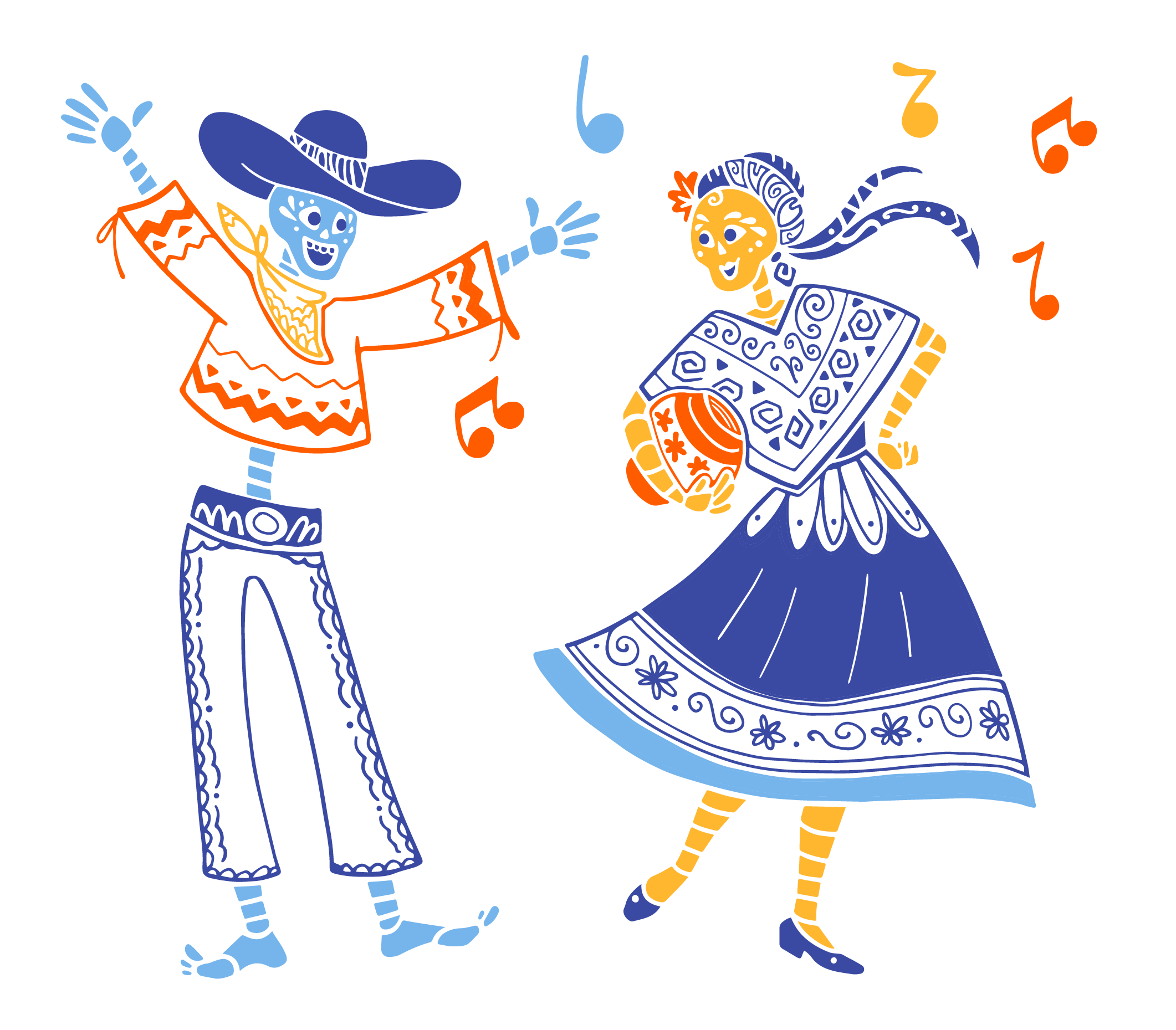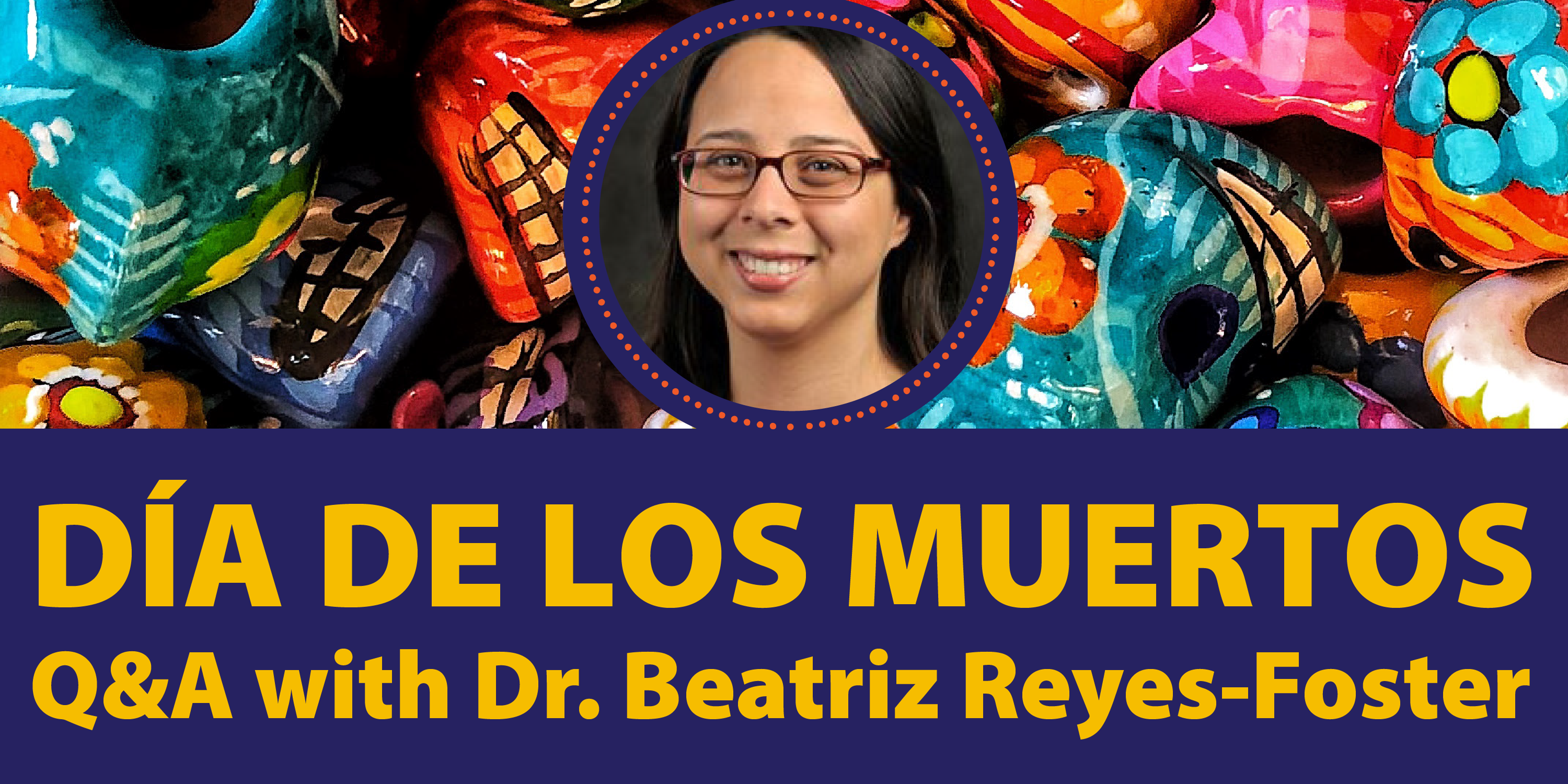What is Día de los Muertos all about? Dr. Beatriz M. Reyes‐Foster, Associate Professor & Graduate Coordinator of Anthropology at UCF, presents Día de los Muertos at Alafaya Branch on Saturday, October 12, 11 a.m. Learn about the history, art and cultural importance of this often-misunderstood holiday. We’ve all seen the beautiful sugar skull art represented in movies like Coco (2018) and The Book of Life (2014), but Dr. Reyes-Foster was kind enough to answer some of the questions beyond the films.
Josh Shidel: For those who may not be aware what Día de los Muertos is, would you mind giving us a basic summary?
Dr. Beatriz M. Reyes‐Foster: Día de los Muertos is a Mexican holiday celebrated on November 1 and 2 where we gather together to remember the people we love who have passed on, and we “welcome” them back for a visit. It is celebrated in different ways across regions of Mexico, but in most places, the celebration includes creating a beautiful altar with photos and objects that remind us of our loved ones. Many families also visit the cemetery and beautifully decorate their loved ones’ tombstones with marigolds and other flowers, food and candles. We make our loved ones’ favorite foods, serve their favorite drinks, and put them on the altar or on the grave so they can enjoy the meal too! People might think this might make us sad, but it is a joyful celebration of the lives of those who came before us. Symbolically, it also helps us remember those who came before we were ever born, our ancestors. Día de los Muertos was declared Intangible Cultural Heritage for Humanity by UNESCO in 2008, meaning it is a holiday that enriches all humanity, not just people of Mexican descent.
JS: Do any other countries outside of Mexico celebrate Día de los Muertos? How do they differ?
BR: Día de los Muertos coincides with the Catholic All Saints’ and All Souls’ Days, which are also days of remembrance. However, in most of the world this only consists of masses said for the day. In Latin America and Spain, people do set up altars. In Latin America, these days are also frequently accompanied with other rituals that are indigenous in origin. So, it looks different across different cultures. However, Mexico is unique in how big the holiday is – in many places, kids don’t even have school!
JS: What are some common misconceptions with the holiday?
BR: A lot of people in the U.S. think that Día de los Muertos is basically a “Mexican Halloween.” Although it is a joyful holiday that we enjoy, the meanings are totally different. For us, it really is about remembering our dead, not about dressing up – even if we do put on calavera makeup, that is really secondary to the holiday. People also think that because the holiday is about our dead, that it is somehow sad or depressing. Although we are sad that our loved ones are gone, we remember them joyfully for all of the good they brought to our lives while they were here. It is a celebration of their lives. I like the idea that their spirits are visiting with us. In some places, people wait a full year before they put a loved one on the altar, precisely because it is really hard to have a party when you are still grieving your loved one’s death.
JS: Are there any special foods associated with the holiday?
BR: Yes! Though these also vary by region. The most visual of the foods associated with Día de los Muertos is pan de muerto, or bread of the dead. It is a sweet leavened loaf with decorative “bones” on top and sugar. It is wonderful with Mexican hot chocolate, a favorite in my home. People also make sugar skulls or calaveras to put on the altar or give as gifts, but they are really too sweet to eat, in my opinion! In Yucatan, where I am from, we make something called a mucbipollo, which is a Mayan word that means “buried chicken” because it was traditionally made in an earth pit. It is a large baked tamale. Kind of like a big, heavy pie with a crust made of corn dough, filled with chicken and pork. I make it every year – it takes me all day!

JS: What is your history with the holiday?
BR: I grew up celebrating Día de los Muertos (we call it Hanal Pixan in Yucatan, which is Mayan for “meal of the souls/spirits”). We would visit the cemetery to see the beautiful decorated graves and my school would have an altar contest where teams of kids would build beautiful altars for people to walk around and enjoy. The altar we would have at home would be much more modest, because it was private. After I came to the U.S. and then had a family of my own, it became really, really important to me to keep these traditions alive for my children, to make sure that our traditions were part of my sons’ memories growing up. I also wanted them to remember my grandparents, who unfortunately did not get to meet them. It is a way for them to know where they come from.
JS: What are your favorite moments during the Celebration?
BR: I love setting up the altar. My kids are still little, so we don’t spend too much time talking about my grandparents. I try to tell them a story from when I was little or a nice memory I might have about them. We have lost two cats in the last few years, so they are also on the altar! It helps them better understand what the holiday is about. I also really enjoy making the food with the kids and of course eating it!
JS: Have you studied Día de los Muertos from an Anthropological perspective?
BR: As part of my PhD studies, I assisted my professor, Stanley Brandes, in finishing his book, Skulls to the Living, Bread to the Dead: The Days of the Dead in Mexico and Beyond, which really gave me a new understanding of the holiday and its roots in indigenous culture. Calaveras reflect Aztec aesthetics, and most Mesoamerican cultures (Aztec, Maya, Olmec, among others) revered their ancestors with offerings of food and drink. Many Mexicans like me are Mestizo, which means we have both indigenous and Spanish ancestors. I really like that Día de los Muertos connects me to my indigenous roots.
JS: Do you have any unique family traditions during the holiday?
BR: We watch Coco and The Book of Life! I bake pan de muerto and make mucbilpollo. We decorate sugar skulls, and I try to find other crafts to do with the kids. And of course, we put up our altar. Every year it gets a little bigger!

